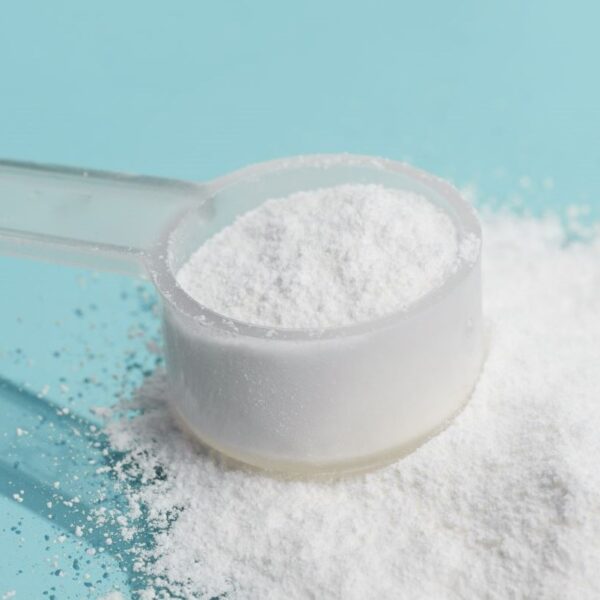Niacinamide, also known as nicotinamide, is a form of vitamin B3 or niacin. It’s the precursor to the cofactors nicotinamide adenine dinucleotide (NADH) and nicotinamide adenine dinucleotide phosphate (NADPH), which are essential for a variety of biochemical reactions in the body.
Niacinamide is commonly used as a dietary supplement, nutrient, and fortificant. Unlike other forms of niacin, niacinamide does not cause skin flushing, making it ideal for use in food and nutrition products.
What is Niacinamide?
Niacinamide is an amide of nicotinic acid. The structure of nicotinamide consists of a pyridine ring to which a primary amide group is attached in the meta position. Nicotinamide is a pyridinecarboxamide that is pyridine in which a carboxamide group replaces the hydrogen at position 3. Niacin supplements are typically recommended when dietary intake of niacin is insufficient.
The term “niacin” or “vitamin B3” is used to denote all forms of niacin and its derivatives that exhibit the biological activity of niacin, including nicotinamide (nicotinic acid amide), nicotinic acid (pyridine-3-carboxylic acid), nicotinamide riboside, and inositol hexanicotinate.
The biological effects attributed to the compound, the rate of uptake and metabolism, and the extent to which biological effects are generated similar to the native form of niacin are considered when considering whether a compound should be referred to as “niacin” or not.
Source: Wikipedia
How is Niacinamide Produced?
Humans can synthesize niacin in the body through tryptophan. On average, 3.3% of tryptophan is converted to niacin. The synthesis of niacinamide starts with 2-Methylglutaronitrile, a byproduct of adiponitrile production, which is converted to 2-methyl-1,5-diaminopentane. Cyclic hydrogenation produces 3-methylpiperidine. Dehydrogenation yields 3-methylpyridine, which is then ammoxidated and partly hydrolyzed to nicotinamide.
Use of Niacinamide in Food Products & Supplements
| Function | Applications |
| Dietary Supplement | Supplements (Capsules, Syrups, Tablets, etc.) |
| Nutrient | Nutrient Premixes |
| Fortificant | Fortification Premixes |
Properties of Niacinamide
| Physical Form | Powder, crystalline powder |
| Color | Colorless to white |
| Odor | Odorless |
| Taste | Bitter taste |
| Molecular Weight | 122.12 g/mol |
| Appearance | Colorless to white crystalline powder |
| pH (10% Aqueous) | Neutral |
| Density @ 25°C | 1.400 g/cu |
| Melting Point | 130°C |
| pKa | 3.35 |
| Refractive Index | 1.466 |
| Solubility (Water, 25°C) | 5 mg/L |
| Storage Conditions | Keep the container tightly closed in a dry and well-ventilated place. Keep away from oxidants. |
Typical Formulations
Multivitamin Tablet Premix
Here is an example of a multivitamin tablet premix formulation table with niacinamide, along with the weight of ingredients:
| Ingredient | Composition (Weight in kg) |
| Niacinamide | 22 |
| Ascorbic acid | 58 |
| Dicalcium phosphate | 85 |
| Cornstarch | 10 |
| Vitamin B1 mononitrate | 2.6 |
| Vitamin B2 | 2.2 |
| Vitamin B6 hydrochloride | 2.2 |
| Vitamin B12 (1:1000 dilution) | 2.5 |
| d-calcium pantothenate | 3.8 |
| Vitamin A Powder (500,000 units/gram) | 12.5 |
| Vitamin D2 Powder (850,000 units/gram) | 0.735 |
| Calcium Stearate | 1.0 |
Source: Google Patents
Vitamin Mix
Here is an example of a vitamin mix formulation table with niacinamide, along with the weight of ingredients:
| Ingredient | Weight (g) |
| Vitamin A | 79 |
| Vitamin E | 92 |
| Vitamin K3 | 94 |
| Vitamin B1 | 60 |
| Vitamin B2 | 93 |
| Vitamin B6 | 67 |
| Vitamin B12 | 42 |
| Niacin | 91 |
| Pantothenic acid | 81 |
| Biotin | 94 |
Source: Google Patents
Nutrient Premix
Here is an example of a nutrient premix formulation table with niacinamide, along with the weight of ingredients:
| Ingredient | Weight (g/kg) |
| Vitamin A (Retinyl) palmitate, spray-dried or equivalent, 0.075 % retinol, min. | 1 |
| Thiamin mononitrate, activity level, 81 %, min. | 7 |
| Riboflavin, activity level, 100 %, min. | 5 |
| Niacinamide, activity level, 99 %, min. | 36 |
| Pyridoxine, activity level, 82 %, min. | 5 |
| Folic acid, activity level, 100 %, min. | 1 |
| Vitamin B12 (Water soluble), activity level, 0.1 %, min. | 0.02 |
| NaFeEDTA activity level, 13 % Fe, min. | 21 |
| Zinc oxide, activity level, 80 %, min. | 76 |
Source: KEBS
Niacinamide Formulation Considerations
While niacinamide has an advantage over other forms of niacin for many applications, product formulators may still choose other forms for various reasons. The following table compares significant properties of the most commonly used forms of niacin:
| Niacinamide | Nicotinic Acid | Inositol Hexanicotinate | |
| Biological Effects | Niacinamide is a precursor to NADP. At a physiological dosage, the effect of nicotinamide and nicotinic acid are indistinguishable. | Nicotinic acid is a precursor to NADP. Supraphysiological doses decrease LDL cholesterol, triglycerides and increase HDL cholesterol. | ~52% of urinary metabolites of nicotinamide were found in subjects, indicating its bioavailability. |
| Effectiveness | Inositol hexanicotinate reduces fibrinogen levels. It provides vasodilatory action, and improves blood viscosity and oxygen transport. | Physiological amounts of nicotinic acid prevent vitamin B3 deficiency. Supraphysiological effects indicated for dyslipidemia, atherosclerosis, and cardiovascular diseases. | Inositol hexanicotinate has minimal to no effect on dyslipidemia. Inositol hexanicotinate is indicated for peripheral vascular insufficiency, Raynaud’s phenomenon. |
| Flushing Effect | None | Prostaglandin D2 mediated vasodilation resulting in cutaneous flush. May occur when intakes exceed 50 mg/day. | None |
| Bioavailability | Niacinamide prevents vitamin B3 deficiency. It does not affect dyslipidemia. | ~52% urinary metabolites of nicotinamide were found in subjects, indicating its bioavailability. | ~70% of the administered dose is absorbed into the bloodstream. |
Source: Nutrition Reviews
Absorption & Metabolism of Niacinamide
Nicotinamide is efficiently absorbed from the gastrointestinal tract. At low doses, absorption is mediated via sodium-dependent facilitated diffusion, whereas at higher doses, absorption is via passive diffusion. Doses of up to three to four grams of nicotinamide are almost completely absorbed. Nicotinamide is transported via portal circulation to the liver and systemic circulation to the body’s tissues. Nicotinamide enters most cells by passive diffusion and enters erythrocytes by facilitated transport.
Niacinamide is metabolized in the liver to N-methylniacinamide, other N-methylated derivatives, and nicotinuric acid (the glycine conjugate of niacin). These metabolites are excreted in the urine.
When ingested in amounts needed for physiologic function as a coenzyme (12-18 mg daily), only a small amount of niacinamide is excreted unchanged in the urine. However, after administering larger doses, a greater proportion of niacin and niacinamide is excreted unchanged.
Safety & Regulatory Considerations
| FDA Information | The German Federal Institute for Risk Assessment (BfR) recommends the addition of nicotinamide to food supplements at a maximum level of 160 milligrams (mg) per daily recommended dose of an individual product. |
| EU Information | The FDA has given Niacinamide GRAS (Generally Regarded as Safe) status. The ingredient is used as a nutrient & dietary supplement. It can be used in food as an ingredient without limitations other than current good manufacturing practices. It may also be used in infant formula. |
| German Regulatory Information | The FDA has given Niacinamide GRAS (Generally Regarded as Safe) status. The ingredient is used as a nutrient & dietary supplement. It can be used in food as an ingredient with no limitation other than current good manufacturing practices. It may also be used in infant formula. |
Health Effects of Niacinamide
Niacinamide is commonly used to treat various nutrient deficiencies and health conditions.
Niacin Deficiency: Niacin deficiency classically results in pellagra, a chronic wasting disease. The biochemical inter-relationship between riboflavin and vitamin B6 involved in tryptophan metabolism suggests the insufficiency of any of these vitamins may also lead to pellagra. Nicotinamide is typically used to treat niacin deficiency which may lead to pellagra.
Hyperphosphatemia Treatment: Niacin and niacinamide derivatives as phosphate-binder agents have been used to control hyperphosphatemia in patients with chronic kidney disease. Nicotinamide inhibits sodium/phosphorus transport in renal and intestinal brush borders and lowers phosphorus levels in patients on hemodialysis.
Type 1 Diabetes (T1DM) Prevention: Treatment with high doses of nicotinamide prevents or delays insulin-deficient diabetes in several animal models of type 1 diabetes and protects islet cells against cytotoxic actions in vitro.
Neurological Degeneration Prevention: Nicotinamide appears to play a role in protecting neurons from traumatic injury, ischemia, and stroke, as well as being implicated in three neurodegenerative conditions: Alzheimer’s, Parkinson’s, and Huntington’s diseases.
Treatment of Certain Skin Conditions: Topical application of niacinamide improves the surface structure, smoothes out wrinkles, and inhibits photocarcinogenesis. It has also demonstrated anti-inflammatory effects in acne, rosacea, and nitrogen mustard-induced irritation.
Melanoma Prevention: Niacinamide may help to prevent melanoma. Niacinamide is thought to work by boosting the immune response to skin cancers and enhancing cellular repair mechanisms.
Safety & Toxicity of Niacinamide
Niacinamide has fewer potential side effects than other forms of niacin. However, taking higher-than-average doses can make side effects more likely. Studies have reported a range of adverse effects, including headache, heartburn, nausea, gastrointestinal disturbances, and fatigue at a dose of 3,000 mg/day.
The Expert Group on Vitamins and Minerals (EVM) has adjusted the intake to a standard body weight of 60 kg to set a total dietary intake guidance level of 600 mg/day NM or 560 mg/day of supplemental niacinamide.
Pregnant and breastfeeding women and children, adolescents, or adults with liver, gallbladder, and kidney diseases are advised to watch their niacin intake and use supplements after consulting a medical practitioner.
Drug Interactions
Niacinamide may alter the level of carbamazepine (Tegretol) or mysoline (Primidone) in the bloodstream, affecting the activity of these drugs. It can also slow down blood clotting and increase the risk of bleeding. It may make the effects of anti-coagulant medications stronger, increasing the risk of bleeding. It can augment the effect of alpha-blockers and lead to a risk of low blood pressure. Niacin binds the cholesterol-lowering medications known as bile-acid sequestrants and may make them less effective.
Because niacinamide supplements can slow blood clotting, avoiding niacinamide with supplements that may also increase bleeding, such as omega-3 fatty acids, ginkgo, natto kinase, ginseng, etc.
Identification Numbers
| Chemical Name | pyridine-3-carboxamide |
| CAS Number | 98-92-0 |
| EC Number | 202-713-4 |
Acceptable Limits or Maximum Usage
Recommended nutrient intakes for niacin are provided in the table below.
| Group | Niacin Equivalents/ Day |
| Infants and children 0-6 months | 2 |
| 7-12 months | 4 |
| 1-3 years | 6 |
| 4-6 years | 8 |
| 7-9 years | 12 |
| Adolescents, 10-18 years | 16 |
| Females, 19+ years | 14 |
| Males, 19+ years | 16 |
| Pregnancy | 18 |
| Lactation | 17 |
Source: FAO/WHO
Multiple factors affect the requirements of niacin in the body. Several dietary, drug, and disease factors reduce the conversion of tryptophan to niacin (e.g., oral contraceptives). Vitamin B6 also plays a role in the tryptophan-niacin pathway.
Fun Facts About Niacinamide
- Niacinamide is used in the skincare industry as an anti-inflammatory and antioxidant to protect the skin against environmental stressors.
- Studies have shown niacinamide to be as effective at treating breakouts as clindamycin when applied twice a day for eight weeks.
Additional Resources
- Wiley Online Library – Nicotinic Acid and Nicotinamide
- PubChem – Nicotinamide
- EUFIC – Niacin: Foods, Functions, How Much Do You Need?
- FAO – Niacin
- ScienceDirect – Nicotinamide
- NIH Office of Dietary Supplements – Niacin (Vitamin B3)
- EUR-Lex – Commission Regulation (EU) No 439/2010
- EUR-Lex – Commission Regulation (EC) No 1925/2006









